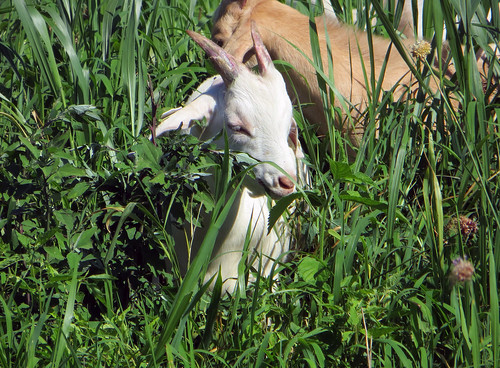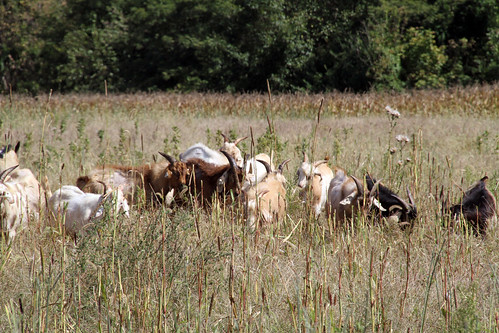For this year's Western Maryland Pasture-Based Meat Goat Performance Test, data for growth (average daily gain, ADG) has been summarized.
Starting and ending weights were determined by weighing the goats two days in a row and averaging the two weights. Starting weights (recorded on July 9-10) ranged from 32.6 to 71.8 lbs. and averaged 49.1 + 8.3 lbs. Ending weights (recorded on October 1-2) ranged from 42.8 to 89.3 lbs. and averaged 62.6 + 8.0 lbs.
The first 13 days of the test served as an adjustment period, to allow the goats to adjust to their new surroundings and pasture mates and to allow time for the worms to clean their systems. Weight gained during the adjustment period does not factor into the test results.
First half: the growth challenge
The first 42 days of the test served as a "growth challenge." The goats grazed warm season annual grasses and legumes (mostly Dwarf Pearl Millet + Sunn Hemp). Forage analysis showed that the annual pastures were very nutritious, though low in dry matter. While the annual pasture lots should have been free from infective worm larvae, the central lane-way was still a source of parasitic infection.
For the first 42 days of the test, ADG ranged from -0.050 to 0.454 lbs. per day and averaged 0.205 + 0.108 lbs. per day. The top-gaining buck was 548 (Murphy, NJ). Fourteen goats, including three of P.J. Murphy's gained over 0.3 lbs. per day. Only two goats failed to gain weight during the first 42 days of the test.
Second half: the parasite challenge
The second half of the test served as a "parasite challenge." The intent was to have the goats graze the cool season grass paddocks (mostly orchardgrass and MaxQ™ tall fescue). Due to lack of rainfall, the cool season paddocks had very little regrowth, so the pasture rotation was less structured. In fact, by the end of the test, the goats had access to the entire pasture system.
The cool season paddocks had previously been grazed by sheep and mowed. In a normal rainfall year, they would have had sufficient opportunity to regrow. There was also ample time for most of the infective worm larvae to die-off.
For the second half of the test, ADG ranged from -0.236 to 0.20 lbs. per day and averaged 0.017 + 0.103 lbs. per day. The top-gaining buck was 539 (Majancsik, KY). Other top gainers (over 0.18 lbs. per day) included 510 (Barnes, KY), 543 (Maynard-Dishman, TN), and 574 (Smith, VA). Thirty-six (43%) of the bucks lost weight during the parasite challenge period (day 42-84). While there was still forage available, forage quality and quantity had declined significantly during the second half of the test.
For the 84-day duration of the test, ADG ranged from -0.092 to 0.255 lbs. per day and averaged 0.111 + 0.073 lbs. per day. The top-gaining buck was 539. Eight goats averaged over 0.2 lbs. of gain per day. In addition to the Majancsik buck, they included 501 (Adams, IL), 543 (Maynard-Dishman), 551 (Nelson, MD), 568 (Purich, VT), 584 (Weber, IL), 586 (Whelan, KY), and 592 (Wilborn, AL). Seven goats lost weight during the test.
Download ADG Summary
Download ADG Rankings
Starting and ending weights were determined by weighing the goats two days in a row and averaging the two weights. Starting weights (recorded on July 9-10) ranged from 32.6 to 71.8 lbs. and averaged 49.1 + 8.3 lbs. Ending weights (recorded on October 1-2) ranged from 42.8 to 89.3 lbs. and averaged 62.6 + 8.0 lbs.
 |
| Click on graph to view larger image in a new window |
The first 13 days of the test served as an adjustment period, to allow the goats to adjust to their new surroundings and pasture mates and to allow time for the worms to clean their systems. Weight gained during the adjustment period does not factor into the test results.
First half: the growth challenge
The first 42 days of the test served as a "growth challenge." The goats grazed warm season annual grasses and legumes (mostly Dwarf Pearl Millet + Sunn Hemp). Forage analysis showed that the annual pastures were very nutritious, though low in dry matter. While the annual pasture lots should have been free from infective worm larvae, the central lane-way was still a source of parasitic infection.
For the first 42 days of the test, ADG ranged from -0.050 to 0.454 lbs. per day and averaged 0.205 + 0.108 lbs. per day. The top-gaining buck was 548 (Murphy, NJ). Fourteen goats, including three of P.J. Murphy's gained over 0.3 lbs. per day. Only two goats failed to gain weight during the first 42 days of the test.
 |
| Pasture was lush in the first half of the test. |
Second half: the parasite challenge
The second half of the test served as a "parasite challenge." The intent was to have the goats graze the cool season grass paddocks (mostly orchardgrass and MaxQ™ tall fescue). Due to lack of rainfall, the cool season paddocks had very little regrowth, so the pasture rotation was less structured. In fact, by the end of the test, the goats had access to the entire pasture system.
The cool season paddocks had previously been grazed by sheep and mowed. In a normal rainfall year, they would have had sufficient opportunity to regrow. There was also ample time for most of the infective worm larvae to die-off.
For the second half of the test, ADG ranged from -0.236 to 0.20 lbs. per day and averaged 0.017 + 0.103 lbs. per day. The top-gaining buck was 539 (Majancsik, KY). Other top gainers (over 0.18 lbs. per day) included 510 (Barnes, KY), 543 (Maynard-Dishman, TN), and 574 (Smith, VA). Thirty-six (43%) of the bucks lost weight during the parasite challenge period (day 42-84). While there was still forage available, forage quality and quantity had declined significantly during the second half of the test.
 |
| Pasture quality and quantity was poorer in the second half. |
For the 84-day duration of the test, ADG ranged from -0.092 to 0.255 lbs. per day and averaged 0.111 + 0.073 lbs. per day. The top-gaining buck was 539. Eight goats averaged over 0.2 lbs. of gain per day. In addition to the Majancsik buck, they included 501 (Adams, IL), 543 (Maynard-Dishman), 551 (Nelson, MD), 568 (Purich, VT), 584 (Weber, IL), 586 (Whelan, KY), and 592 (Wilborn, AL). Seven goats lost weight during the test.
Download ADG Summary
Download ADG Rankings











